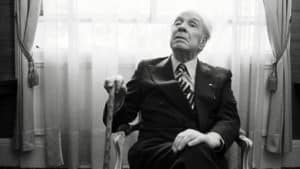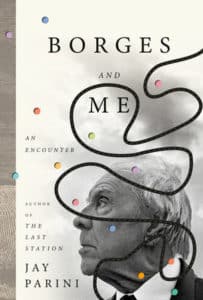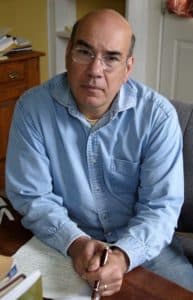I once took a graduate seminar on the Latin American novel. We read two authors I had heard of—Gabriel Garcia Marquez (One Hundred Years of Solitude) and Carlos Fuentes (The Death of Artemio Cruz)—and several I had not heard of, including Mario Vargas Llosa (The Green House, The War of the End of the World) and Manuel Puig (Kiss of the Spider Woman). All of them were associated with the Latin American Boom of the 1950s-1970s, when the literature of magic realism burst upon the literary world.
Our professor pointed to two writers who served, if unknowingly, as the godfathers of the Boom, the two who freed younger writers from the confines of the traditional novel. One was an American, William Faulkner. If you’ve read Faulkner, you know what he did with his novels. The other writer was the Argentine Jorge Luis Borges (1899-1986), the poet, short story writer, essayist, and general literary genre-bender. One of Borges’ best-known works is a one-page short story, or perhaps an essay, entitled “Borges and I.” He explores his own identity as a writer and a person, seeing them as separate entities. And he wonders which one wrote the story.
In 1970, Jay Parini was an American graduate student at the University of St. Andrews. He was befriended by poet and writer Alastair Reid, who had translated some of Borges’ poetry. And Borges was coming to spend time with Reid in Scotland. Except Reid’s uncle in London was seriously ill, and Reid had to leave. He left Borges in the hands of Parini, who was simultaneously beginning research on the writer George Mackay Brown, writing his own poetry, hoping that a fellow student named Bella would like him as much as he liked her, and avoiding a succession of letters from his draft board back in Pennsylvania.

Jorge Luis Borges
Parini thinks he will be spending a week at Reid’s house, trying to keep Borges entertained. Instead, when he arrives, Borges informs him that, since Parini has a car, they are going on a tour of the Scottish Highlands so he can visit a friend in Inverness. And off they go, in an automobile so ramshackle that Borges names it Rozinante after Don Quixote’s horse and tries to convince Parini that he is really Sancho Panza. When that fails, he consistently calls Parini “Guiseppe,” after the 18th century Italian poet.
What was supposed to be a housebound author-sitting job turned into a road trip. Borges and Me is the account of what happened 50 years ago. It’s also something of a play on the story by Borges, and for good reason. Parini quickly learns he has to work very hard indeed to separate his own identity from that of his guest and fellow traveler. And half a century later, he’s not sure if he succeeded.
Parini wasn’t only a tour guide. He was also Borges’ eyes, because the author was blind. Borges will experience the Scottish Highlands like he experienced literature, through the eyes and voice of others, and mostly through “Giuseppe’s.” It’s a fascinating and delightful story. Borges forgets he’s blind and tends to make large expansive gestures and moves, once tumbling down a hillside and then nearly drowning himself and Parini in Loch Ness. He also has a tendency to relieve his bladder whenever he needs to, often by the front left tire of Parini’s car. Perhaps Borges was trying to escape what he describes in a poem.
On his blindness

a luminous mist surrounds me, unvarying,
that breaks things down into a single thing,
colourless, formless. Almost into thought.
The elemental, vast night and the day
teeming with people have become the fog
of constant, tentative light that does not flag,
and lies in wait at dawn. I longed to see
just once a human face. Unknown to me
the closed encyclopaedia, the sweet play
in volumes I can do no more than hold,
the tiny soaring birds, the moons of gold.
Others have the world, for better or worse;
I have this half-dark, and the toil of verse.
The heart of Borges and Me is the discussions that the two men, one young and one old, have on literature, love, unrequired love, other authors, food, war, loss, and more. When Parini hears of a friend’s death in Vietnam, Borges will comfort him in one of the most touching scenes in the book.

Jay Parini
Parini is the author of six collections of poetry, eight novels, five biographies (John Steinbeck, William Faulkner, Robert Frost, Gore Vidal, and Jesus), and five works of nonfiction. A graduate of Lafayette College and the University of St. Andrews (yes, he did receive his Ph.D. in 1975, but not for work on Gordon Mackay Brown), he’s received numerous fellowships, honorary degrees, and literary awards. His books have been translated into more than 30 languages. He lives in Vermont, where he serves on the faculty of Middlebury College.
In my Latin American novel class, we did read a little of Borges, but only very little. Our focus was the generation after him, the generation he helped inspire. It’s easy to see why, and Borges and Me makes very clear the man’s originality as an author, a character, and a conversationalist. What a delight of a road trip that must have been, assuming you survived Borges’ gestures.
Photo by bluesbby, Creative Commons, via Flickr. Post by Glynn Young.
__________________________

“I require all our incoming poetry students—in the MFA I direct—to buy and read this book.”
—Jeanetta Calhoun Mish
- Poets and Poems: Michelle Ortega and “When You Ask Me, Why Paris?” - April 10, 2025
- Robert Waldron Imagines the Creation of “The Hound of Heaven” - April 8, 2025
- Poets and Poems: Luci Shaw and “An Incremental Life” - April 3, 2025

L.L. Barkat says
This sounds marvelous. Do you think it would make a good book club selection here at Tweetspeak? 🙂
Glynn says
I think it would. It’s not overly long and it’s an engaging narrative – you keep reading to see what Borges will do or say next.